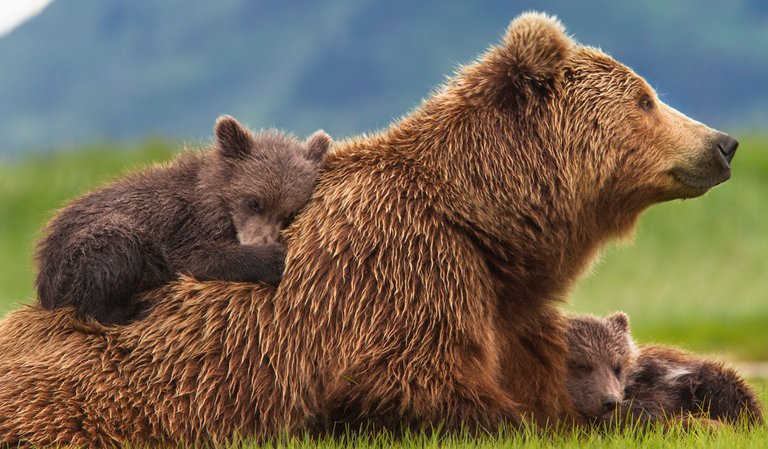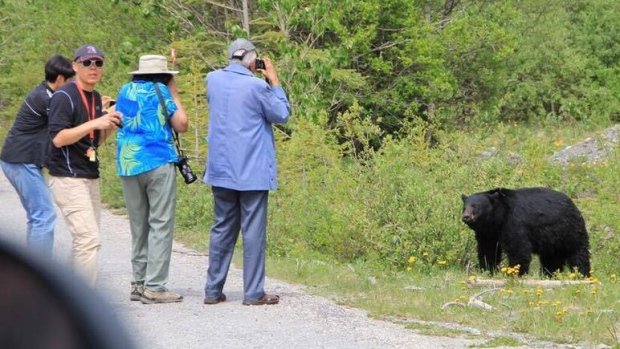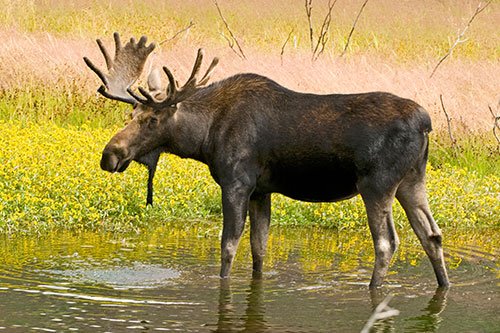Hey guys,
On today's article, I am going to talk about how important your behavior is towards wildlife. I will explain the correct actions to take in case on the encounter of specific Canadian animals. Actions, that could save your life, and the one of the animal. I think that it is an important subject because I have seen a lot of dangerous actions taken by tourists. The animals that will be covered are the Grizzly, Black bears, Wolves, Cougars, lynx, the moose and the elk.
Grizzly:

If you are heading in the popular national parks in Western Canada, your chances of seeing a Grizzly are actually pretty high. You will probably see them while you are on the road, which means that you will be in your car. It should stay that way. Do not get out of your car at any point if you see a Grizzly bear at a few meters in the woods.
It is okay to stop, enjoy the moment, take a few pictures and keep on driving.
With Grizzlies and any other animals, you will see the dumb tourist effect. The first person to see the bear will get out of his car and keep good distance, then an other one will see the first out of his car, assuming it is safe, and feeling safe because he is not alone. Therefore, he will get closer. A third tourist passes by. See a couple people close to a bear. Oh it must be alright. He'll get closer. And this continues on and on until people erase their fears of the animal and keep getting closer until they 're only a couple meters away.
That means a dozen of tourists around a bear. Maybe you aren't scared anymore, but guess what, the bear is starting to stress out. What does a scared bear do? Run away, ruining the moment for everyone. or fight, ruining your life. And his at the same moment because an aggressive bear is a dead bear.
According to Parks Canada, a safe distance with a grizzly would be 100 meters.
If you are hiking and happen to see a grizzly, do not approach him. Try to walk around him and continue your way. If the bear sees you, DON'T MOVE. Wait and see what he thinks of you. Chances are he wont care, if he doesn't keep your distance and try to continue your hike walking around him.
If he shows aggressive sings, and approaches you, consider climbing a tree. (if you intend to stop your reading here, DO NOT FOLLOW THAT ADVISE FOR BLACK BEARS.) or just slowly move away from it, never turning your back.
If he shows sings of attack, like running towards you, get in fetal position and play dead. DO NOT RUN. they run way faster than you.
If you have bear spray, stand your ground and start shooting when the bear is 7 feet away (approx 2 meters). That will make him back off.
Black bears:

Here is a perfect example of the dumb tourist effect. It happen not to long ago in Banff. Never get that close to a black bear! In fact, black bears can be more aggressive towards humans than grizzlies.
According to Parks Canada, a safe distance with a black bear would also be 100 meters.
The same rules apply if you see one while driving.
If you are hiking, things change a bit. If the bear looks aggressive but doesn't approach you, look as tall and big as possible and scream. Grab a stick, move it fast and scream anything, that should make it go away. If he approaches you, walk away slowly, never turn your back and keep talking to him. Anything. It is unfortunately too late too scream. Chances are you will have to back off until you are at a safe place like your car. DO NOT CLIMB A TREE. They are like monkeys.
Same rule applies if you have pepper spray. Stand your ground, wait till it's 7 feet (2 meters away), shoot.
Wolves:

Your chances of seeing wolves are really slim. In fact, you aren't really suppose to see them. If you do while driving, don't even think getting out of your car.
If you are hiking, a seen wolf is a surprised wolf. A surprised wolf will either run away or show aggressiveness. If you are unlucky and it shows aggressiveness, move slowly to get a weapon like a stick or a rock, and start screaming. Appear as tall as possible. Do anything you can to dissuade him from attacking you. The only way you are getting out of this without injuries is if it thinks it's gonna die if it attacks you.
In case of an attack, there is 2 schools of thoughts. 1. curl in a ball and protect your head. 2. Fight. Know that a wolf is rarely alone and that if you choose to fight, you might have to fight more than one.
The last thing you want to do is start running. Wolves are predators and will take you for food if you play prey. Your chance of surviving a run are really slim.
Cougars:

Even rarer than the Wolf. Your chances to see one is minimal. That doesn't mean that they won't see you tho. Same as the wolf a seen cougar is a surprised cougar. And just like the wolf, it will either leave or show aggressiveness.
If it does the later, start backing up slowly, never turn your back and scream. Appear as big and strong as possible. Absolutely no running. Back up till you reach a sage spot like your car. In case of an attack, your chances of winning that fight are hopeless unlike the wolf.
Lynx:

Exact same as the cougar.
Moose :

If you see a Moose on the road, feel free to stop and take some pictures. Do not get out of your car. Even tho they are herbivores and no killing machine, they still can be aggressive and will inflict you serious damage.
If you see one on a hike, keep safe distance.
If it shows aggressive behavior, back off slowly and never turn your back.
If it runs towards you, RUN. try to stay behind a big tree. If it seems hopeless, curl in a ball and stay in that position until it leaves.
Elk:

You will be able to see these guys from fairly close in the streets of the town or anywhere really. They are usually pretty use to humans and wont mind you that much unless you: Go to close from them, follow them, surround them with your group.
When looking at them, you must always let them a way to escape if they get scared. Male Elk can turn pretty aggressive if they feel like you are too close to them.
In case of an attack, do exactly like a moose.
Do not feed them. EVER.
Well that pretty much concludes that article, if you have any questions, feel free to ask them and I will answer with pleasure! See you next time and remember, be a smart tourist!
PS. Pictures have been taken from google for the sake of the article. None of these pictures are mine.
Great advice, vinnynomad! With the cougars, should we scream or not scream? Should we scream to try to scare off all aggressive predators?
And I remember there were some predators that we should avoid eye contact with and some that we should make eye contact with, but I couldn't remember which was which....
Hey man! Thank you for the good questions! Yes, screaming and appear big is usually what you should do in case the animal looks like it is not going to run away.
As for eye contact, you should not look at wolves or bears in the eyes. Why? Because they do not see you as a prey. They see you as a threat. Keeping eye contact with them is like challenging them. It will only make them more aggressive as it will confirm their beliefs that you are an aggressive threat.
As for cougars, and most felines, you should look at them in the eye at all times because they do think of you as a prey. Making sure to keep eye contact make them think that you are confident in your chance of wining the confrontation and therefore that you will not go down without inflicting injuries to the animal yourself.
Thanks for your reply, vinnynomad. I'll try to keep those tips in mind. Basically, look at all cats in the eyes - if it's not a cat, don't look it in the eyes.
Yup, exactly!
Beautiful post